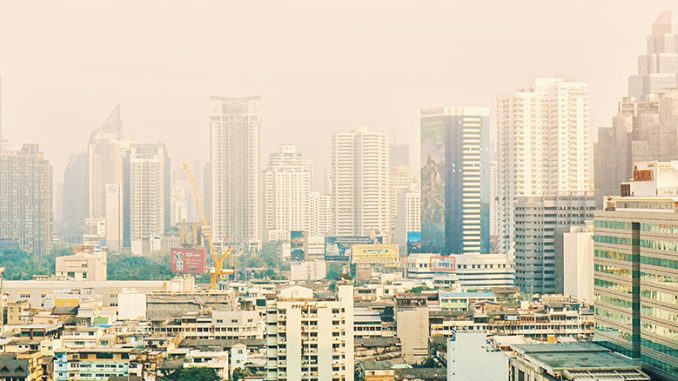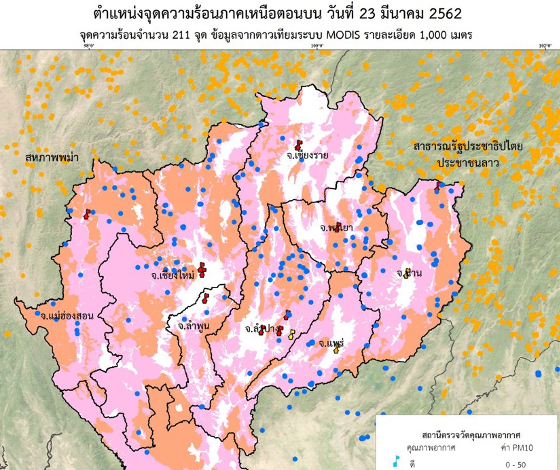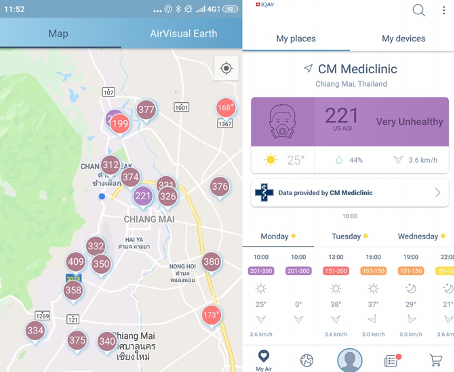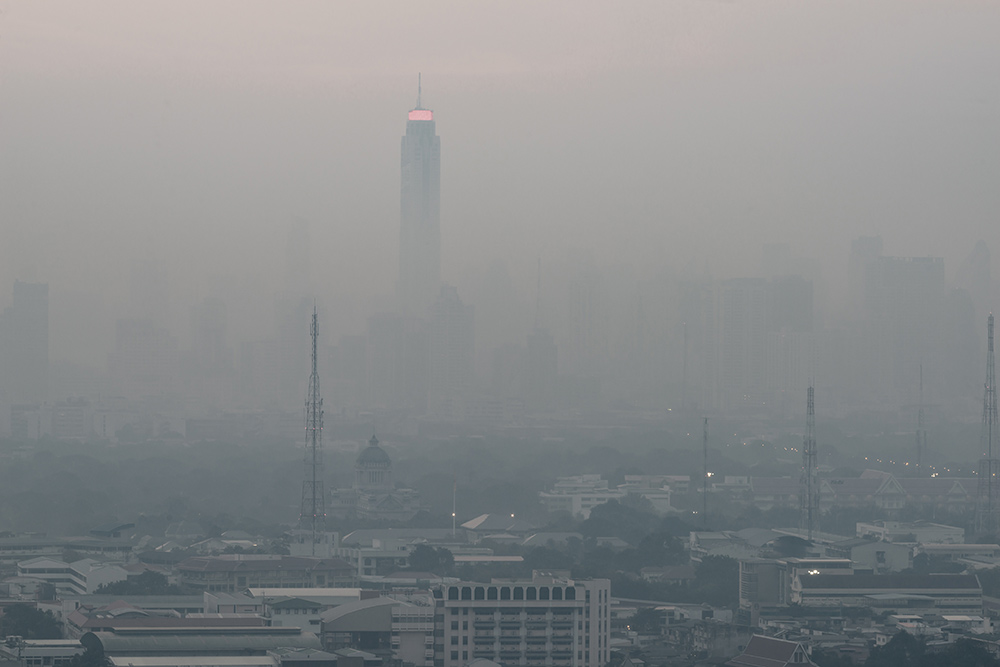
Air pollution is becoming an even more serious problem for many countries in Southeast Asia. Thailand is now experiencing the smoke haze “seasonally”, especially in the northern and central parts of the country. Singapore and Malaysia experience the same problem and, since 2013, the problem has affected both countries more regularly. While the governments of these Southeast Asian countries are trying to find ways to solve the problem and lessen the effect, many people have also found another way to keep themselves safe by using the smart phone applications, such as AirVisual and Air Quality, which enable users to measure and forecast the levels of the air quality during the haze season. Moreover, they allow users to share the air environmental data on the social media platforms, alerting other users living in near-by areas or in other regions in the country to be aware of the crisis. This article would have not been used by users for other purposes. In Thailand, these air quality data powerful tool for people to oppose the rules and centralising power of the military-dominated governments.
Problem beyond Nation and Government
The haze that often occurs over the sky of many Southeast Asian countries is a complicated environmental problem which is difficult for one national government to solve. The haze, which mostly comes from agricultural burns and fires, can be originated in one country, but can fly over the national border to affect another country. This is often the case in northern Thailand. Of course, during the “haze season” in northern Thailand, from March to May, there are many burning activities in the region. However, in recent years, satellite data also show that many “hot spots” can be seen in the areas beyond the Thai border. Research findings show that these hot spots in other countries also come from the burning activities carried out to prepare the lands for “large-scale plantation”. And when the wind blows, the smoke travels crossing the border to the areas in other countries. In this situation, the preventive measures by the local authorities and national government that focus on particular local communities is never enough. The haze is a transregional problem that has creates great impact on many local communities. And this is why there is a high level of the haze in many areas in northern Thailand, although the local governments in Thailand have attempted so hard in controlling the burning activities from the people in the communities.

The Role of Smartphone Applications
While we wait for a more effective and genuine collaboration among the countries in the region in tackling the air problem, currently one of the options that is left for people living in effected areas is to rely on protective measures and technology. In the past few years, smartphone applications that are designed to be able to display the levels of air quality have been very handy for many people who live in the areas that are affected by the smoke yearly. The way in which the air-monitoring applications work is that they retrieve the data of the level of particulate matters (PM2.5 and PM10) from the air monitoring stations which are set up in various locations. Then, on these applications, these data are visualized in an easily comprehensible way. Many companies that own these applications also sell portable air-quality measuring machines which can send data publicly to these applications. The invention of these air-quality applications has been beneficial for many people. Moreover, some of these applications can even retrieve other kinds of meteorological data, such as wind and current, and integrate and visualize them together with the data about particulate matters in the air. Probably, the most useful feature of these applications is the ability to forecast the flow and intensity of these particulate matters. This feature helps many users to the tendency of the condition of the air environment in next hours.

The Community Aspect and Social Power of Applications
The interesting aspect of these air-quality monitoring applications is not only at its quick access to critical environmental information, but also at its potential to create a community and social power. This aspect is made possible when users use the applications with the social-network applications. When the air environment gets worse, many social-network users living in affected areas would share the images captured from the air monitoring applications on the social network. When many users in near-by area do this similarly, it becomes a kind of real-time environmental report. Definitely, this online culture during the air environmental crisis increases public concern quickly and, sometimes, send a collective voice to authorities, pressuring them respond to resolve the problem.
In January 2019, when Bangkok was hit by severe haze, many people promptly posted on their social networks the pictures that show the PM2.5 data of many locations in Bangkok. The posts are often accompanied by complaints and demands that the local and national authorities do something to protect the health of the citizens. Bangkok ordered to close schools temporary on 30 January. In the following March in the same year, when Northern Thailand was hit by another wave of haze (about 140 micrograms per cubic meter), many people went to make comments on the Facebook Page of Chiang Mai University, urging the university to take protective actions. On 13 March, the university finally announced to suspend classes for a few days and suggested the students to stay in safe place. The environmental data that these applications help publicize, in a visually comprehensible way, have become a socializing tool for the people living in risky areas to create bond and to use it to regulate the authorities to respond the problem.
Government’s Reluctance to Embrace Public Data
It would have been an interesting development of the Thai civic culture only if the governments were willing to accept the engagement from the public in helping regulate the air environmental conditions. In reality, when the air quality gets worse to the level that can affect health, the governments often seem to be reluctant to accept the fact and quickly take protective measures in advance. The governments tend to be defensive, waiting for their own governmental sectors such as Pollution Control Department or Ministry of Public Health to “confirm” that the situation is in crisis, before they take actions. On 14 January 2019, when the sky of Bangkok had turned grey and the PM2.5 level was increasing to around 110-120 micrograms per cubic meter, which is considered as “unhealthy”, the authority in Pollution Control Department announced that the condition was still not critical and we “could take care of it” (aow yu, in Thai). The later statement frustrates many residents of Bangkok as it shows the defensive approach in dealing with the air pollution problem. How can the government be able to “take care of” this environmental disaster which is trans-regional and unlikely to be predict in its nature?

Even worse is that, sometimes, without knowing how to resolve the problem, the governmental units in some local areas decide to act “tricky”. In some years, there would be candid images emerging in the Internet that show someone attempt to water the air-quality monitoring stations. While no one can identify these persons clearly, we can guess that there are some organizations or institutions that do not prefer the poor index of air quality to be seen by the public for so long, as it might damage the reputation of the local governmental sector.
Air Environmental Data as Tool for Negotiation with State
Here is where the culture of sharing the air-quality data gets most interesting. It can lend itself to become part of the negotiating power against the Thai state’s centralizing power. Since the military coup in 2006, Thailand has fallen into the path to become a more centralized state. Provincial governors, who are appointed and sent by central government in Bangkok, have gained more power and roles in controlling provinces. However, this can become a problem for big and urbanized cities, like Chiang Mai or Phuket. Especially, when these cities face with complicated social or environmental problems, they need leaders who have well understanding of the cultures of local people in order to come up with the most effective executions. During the haze crisis in Chiang Mai in March 2019, when the governor failed to promptly take action, many social-network users in Chiang Mai quickly shared the poor data of Chiang Mai’s air quality online and they united with one another to chase the governor away from his position, although, technically speaking, he cannot be “fired” by the local people. Many users also went further to call for a bureaucratic reform, requesting Chiang Mai can elect its own governor. Obviously, these people hoped that the governor who is elected by the locals would be able to solve the environmental problems more efficiently.

In Thailand, especially in the northern region, the air environmental crisis is no longer just about the environment. The accessibility of the public environmental data enabled by the digital technology has created even more pressure for the Thai state to maintain its legitimate power. The struggle between people and the state in the 21st century has, thus, become in the form of information war, where the state attempts to gain more control over and, perhaps, to manipulate the public data. This is not something new. China, Thailand’s long-time “big brother”, has done it. Will Thailand follow the path laid by its brother? The future looks quite hazy now.
Pasoot Lasuka
Pasoot Lasuka is an assistant professor in literary studies at English Department, Faculty of Humanities, Chiang Mai University. He teaches and research about literary and visual cultures in Southeast Asia, especially those which are related to the digital technology and online social-media platforms.
Banner Image: Bangkok, THAILAND -JANUARY 18, 2020. Image Richman Photo / Shutterstock.com

Smoky mountain C.M.is not impossible if the Thai do it the right way. The problem is a lack of straight and harmony of the poor citizen, they are a great bashing society(number one on FACEBOOK) but at the same time stabling others on the back always. What this needs now is a strong leader but Honesty hard to find because the is a big gun on top and behind. Do or Death, take one choice, this nation is controlled by a Mafia government, just like the US but different drama.